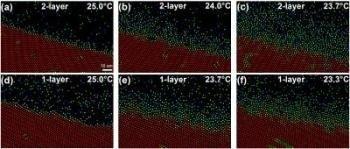Mar 17 2016
A solid’s surface usually melts into a thin liquid layer prior to the melting point. This phenomenon of surface melting occurs in all categories of solids: for example, two ice cubes can fuse at a temperature less than 0°C as the premelted surface water is surrounded inside the bulk at the point of contact and is frozen. Premelting promotes crystal growth, and is vital in geology, metallurgy, and meteorology, such as frost heave, snowflake growth, glacier movement, and skating. As there is a lack of microscopic measurements, the causes of several premelting scenarios and the impact of dimensionality on the premelting phenomenon are poorly understood.
 This image shows the surface premelting of bilayer (a-c) and monolayer (d-f) crystals. The color scale (shown in a) indicates the magnitude of the orientational-order parameter of each particle, |ø6j|. (Credit: Department of Physics, HKUST).
This image shows the surface premelting of bilayer (a-c) and monolayer (d-f) crystals. The color scale (shown in a) indicates the magnitude of the orientational-order parameter of each particle, |ø6j|. (Credit: Department of Physics, HKUST).
To increase the understanding, researchers from the University of Amsterdam and the Hong Kong University of Science and Technology (HKUST), took part in a study that measured surface premelting with single-particle resolution, using novel colloidal crystals. They realized that dimensionality is critical to bulk solid-solid transitions and bulk melting. These effects strongly influence surface melting patterns. In contrast to the heterogeneous melting from surfaces that is commonly assumed, it was found, to the surprise of researchers, that a crystal with free surfaces (solid-vapor interface) melted in a homogenous manner within the bulk and from both surfaces. These observations challenge the melting and premelting theories.
Yilong Han, associate professor of physics, lead the research team along with Bo Li, a graduate student from HKUST. HKUST graduate students Di Zhou, Feng Wang, Yi Peng, and postdoctoral researcher Ran Ni from the University of Amsterdam in Netherlands also participated in the research.
The research work is published in Nature on March 14, 2016 (doi:10.1038/nature16987).
Micrometer sized colloidal spheres in liquid suspensions are often used as model systems for phase transition studies, since their thermal-motion trajectories can be visualized in an optical microscope.
Previous studies mainly used repulsive colloids, which cannot form stable solid-vapor interfaces. Here, we made a novel type colloid with temperature-sensitive attractions which can better mimic atoms, since all atoms have attractions, or otherwise they cannot condense into stable solid in air. We assembled these attractive spheres into large well-tunable two-dimensional colloidal crystals with free surfaces for the first time. This paves the way to study surface physics using colloidal model systems. Our first project along this direction is about surface premelting, which was poorly understood before. Surprisingly, we found that it is also related to bulk melting and solid-solid transitions.
Yilong Han, Associate Professor of Physics, HKUST
The research group witnessed an exotic phenomenon, referred to as incomplete blocked premelting, when they found that two-dimensional (2D) monolayer crystals premelted into a thin layer of liquid with a constant thickness. In contrast, the surface-liquid thickness reaches infinity levels for a two- or three-layer thin-film crystal as it nears its melting point, i.e. a traditional complete premelting. Such types of blocked surface premelting have sometimes been seen in germanium and ice, but the phenomena lack theoretical explanations.
Here, we found that the premelting of the 2D crystal was triggered by an abrupt lattice dilation because the crystal can no longer provide enough attractions to surface particles after a drop in density. Before the surface liquid grew thick, the bulk crystal collapsed and melted due to mechanical instability. This provides a new simple mechanism for blocked premelting. The two-layer crystals are mechanically stable because particles have more neighbors. Thus, they exhibit a conventional surface melting.
Bo Li, Graduate Student, HKUST
The lattice symmetry is not affected by an abrupt dilation, so it is an isostructural solid-solid transition, which can be typically observed in multiferroic and metallic materials. The colloidal system offers the first experimental evidence of isostructural solid-solid transition at the single-particle level.
The mechanical instability triggered a homogenous melting from within the crystal, instead of a heterogeneous melting from the surface.
We observed that the 2D melting is a first-order transition with a homogeneous proliferation of grain boundaries, which confirmed the grain-boundary-mediated 2D melting theory. First-order 2D melting has been observed in some molecular monolayers, but the theoretically predicted grain-boundary formation has not been observed before.
Yilong Han, Associate Professor of Physics, HKUST
This research received support from the Research Grants Council of Hong Kong and the Netherlands Organisation for Scientific Research.